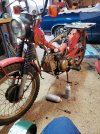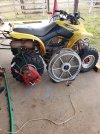b52bombardier1
Well-Known Member
Hello,
I have not started a build thread for a while but here we go. A buddy of mine dragged home a deer camp " haul the dead deer out" 1984 Monza Red (I think) CT 110 barn find bike and wants me to get it running - I've never done a Honda bike so new so IDK . Ran from 1984 until 1994 but nothing since then - about 830 miles on the odometer. Cosmetically awful, dirty, rusty chrome wheels, missing the battery side cover, seat foam and cover falling apart, no rear brake light or tail light assembly. Really bad rusty fuel tank. But has 140 PSI of compression and at least a weak spark out of the CDI ignition module. And two ignition keys, an owners manual, the 1984 Safety Inspection sticker and a clear Texas title. No tool kit.
If anybody has been missing their Bambi pet deer from near Austin, Texas during the 1984 to 94 time frame, I can probably still find a blood sample for you suitable for DNA testing off the luggage rack. Might be blood mixed in with other deer, the occasional pig, etc. so good luck.
Pictures in a few days.
Rick
I have not started a build thread for a while but here we go. A buddy of mine dragged home a deer camp " haul the dead deer out" 1984 Monza Red (I think) CT 110 barn find bike and wants me to get it running - I've never done a Honda bike so new so IDK . Ran from 1984 until 1994 but nothing since then - about 830 miles on the odometer. Cosmetically awful, dirty, rusty chrome wheels, missing the battery side cover, seat foam and cover falling apart, no rear brake light or tail light assembly. Really bad rusty fuel tank. But has 140 PSI of compression and at least a weak spark out of the CDI ignition module. And two ignition keys, an owners manual, the 1984 Safety Inspection sticker and a clear Texas title. No tool kit.
If anybody has been missing their Bambi pet deer from near Austin, Texas during the 1984 to 94 time frame, I can probably still find a blood sample for you suitable for DNA testing off the luggage rack. Might be blood mixed in with other deer, the occasional pig, etc. so good luck.
Pictures in a few days.
Rick


